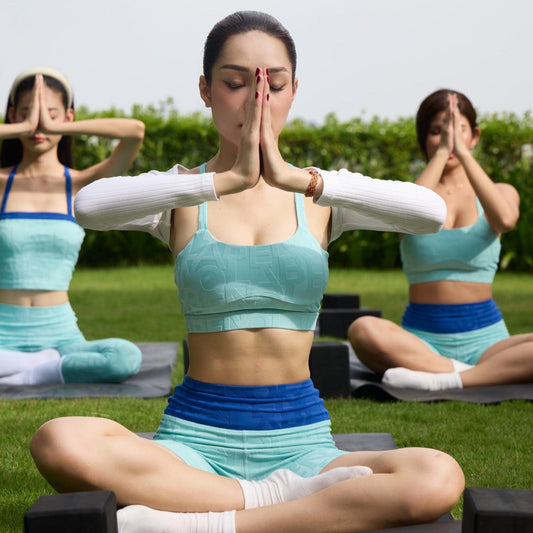Yoga is not merely a sequence of physical postures but also a profound philosophy of life, fostering a deep connection between body, mind, and spirit. Among its core principles, the 8 Limbs of Yoga (Ashtanga Yoga) are regarded as the foundation guiding practitioners toward balance and enlightenment.
At Olaben, the journey of exploring the 8 Limbs of Yoga goes beyond theoretical understanding — it’s about inspiring you to integrate these principles into every practice session and into your daily life. This is the key to strengthening your health, nurturing your soul, and living more fully.
I. Yamas – Universal Ethics
Yamas consist of five core principles of living. They are not merely a list of “dos” and “don’ts” but a moral compass that reveals the innate goodness within: compassion, generosity, honesty, and inner peace.
- Ahimsa – Non-violence (Compassion for all beings): Ahimsa means refraining from causing harm or cruelty to any living being, whether through words, actions, or thoughts. In yoga, Ahimsa encompasses kindness, friendliness, and thoughtfulness toward all people and things, coupled with a sense of responsibility in every circumstance. Practicing Ahimsa means always choosing considerate, non-harmful responses in any form.
- Satya – Truthfulness: Satya means living and speaking the truth, but not indiscriminately. Before speaking, one should consider the content, the manner of delivery, and the impact on the listener. If the truth would cause unnecessary harm, silence may be the better choice. Satya should never conflict with Ahimsa, as truth must be paired with compassion.
- Asteya – Non-stealing: Asteya is refraining from taking anything that does not belong to you, including property, time, or the trust given by others. It also means respecting usage rights and not exploiting resources or opportunities granted to you. Asteya reminds us to avoid unconsciously “stealing” others’ attention or efforts.
- Brahmacharya – Moderation: Often interpreted as moderation in all aspects of life — especially in sexuality — Brahmacharya nurtures healthy relationships and spiritual awareness. It doesn’t necessarily mean celibacy; rather, it is about using energy consciously, avoiding harm to yourself or others.
- Aparigraha – Non-greed: Aparigraha means taking only what is necessary and avoiding excessive accumulation. Yoga practitioners understand that hoarding reflects a lack of trust in the future and the universe. Aparigraha teaches us to release attachment to material possessions, recognizing that change is the only constant.
When these five principles become part of daily life, Yamas purify character, contributing to a happy, healthy, and harmonious community.

II. Niyama – Personal Observances
Niyamas are inward-focused disciplines that help shape and sustain a meaningful life. While Yamas emphasize how we relate to the world, Niyamas focus on self-care and personal growth.
- Sauca – Purity: Sauca refers to cleanliness both externally and internally. External purity means keeping the body clean; internal purity involves maintaining healthy organs and a clear mind. Practicing asana and pranayama cleanses the body and mind, eliminating toxins and negative emotions like anger, greed, or envy.
- Santosa – Contentment: Santosa means being grateful and content with what you have, even during difficulties. It is an inner peace that comes from trusting that everything unfolds according to the law of karma, allowing us to embrace the present moment with ease.
- Tapas – Self-discipline: Tapas is the disciplined, conscious use of energy to maintain a healthy body and resilient spirit. Literally meaning “to heat,” Tapas refers to purifying through effort — focusing energy toward the ultimate goal of union with the highest truth. It includes mindful eating, posture, breathing habits, and daily living.
- Svadhyaya – Self-study: Svadhyaya is the practice of introspection and self-examination. This could involve reading, learning, meditating, or simply recognizing personal limitations with honesty. The aim is to foster self-awareness and transform negative patterns.
- Isvarapranidhana – Surrender to the Divine: Isvarapranidhana is placing all thoughts and actions under the guidance of a higher power. It goes beyond belief — it’s about aligning oneself with the flow of the universe and taking time each day to connect with and express gratitude for the source of life.
Niyama helps each person build a spiritual foundation and a deep sense of purpose, radiating positivity to the world around them.

III. Asana (Yoga Postures)
Asana is the practice of physical yoga postures — the most widely recognized aspect of yoga, especially by those unfamiliar with the other seven limbs in Patanjali’s Yoga Sutra. Moving the body into various postures not only offers clear benefits such as improved health, strength, balance, and flexibility, but also carries a subtler meaning: in Sanskrit, “asana” means “seat” or “to dwell,” suggesting the act of being present in the body and breath. It is a tool to calm the mind and connect with one’s deepest essence.
Each posture is a challenge, allowing us to explore and refine our emotions, concentration, intentions, beliefs, and integration of the physical and subtle bodies. Pushing the boundaries of physical limits becomes a bridge between the tangible world and the unseen forces that shape our lives. Through overcoming challenges, we learn to let go, finding peace in the balance between physical experience and spiritual depth.
Practicing asana not only prepares us for meditation but is also a form of meditation in itself. When one flows with movement and feels their inner strength, the body radiates a bright spiritual quality. Each posture becomes a doorway to expanded awareness, influencing every aspect of our being. The key to unlocking this awareness lies in the breath — leading naturally to the fourth limb, Pranayama.
Patanjali noted that combining Asana with Pranayama harmonizes the body’s energy flow, promoting ideal health and spiritual evolution. Practicing Asana is a way to reconnect with the body, living in harmony with the deep wisdom it carries. As B.K.S. Iyengar said: “The needs of the body are the needs of the divine spirit within. A yogi need not seek God anywhere else; God dwells within.”

IV. Pranayama (Breath Regulation)
Pranayama is the art of controlling and regulating the breath — refining the life force energy (prana) within the body. In Sanskrit, “prana” means “life force,” while “ayama” means “extension” or “expansion.” Together, Pranayama is more than breathing exercises; it is the cultivation and expansion of inner energy, fostering a deeper connection between body, mind, and spirit.
By observing and adjusting the breath, we can influence emotions, focus, and biological rhythms. Inhaling fills the body with positive energy; exhaling releases tension. Each breath cycle becomes a cleansing process for both body and mind. Pranayama slows the heart rate, lowers blood pressure, improves concentration, and prepares the mind for deeper meditation.
In yoga, Pranayama is the bridge between Asana and the higher limbs. Combined with postures, breath guides movement, increasing strength and flexibility. Combined with meditation, it stills the mind, opening greater awareness.
As B.K.S. Iyengar said: “Breath is the bridge to life. It keeps the body and mind together.” When the breath is steady, the mind becomes calm, preparing us for the fifth limb — Pratyahara.

V. Pratyahara (Withdrawal of the Senses)
Pratyahara is the practice of withdrawing the senses from external distractions and turning awareness inward. In modern life, we are constantly bombarded with sounds, sights, information, and emotions from our surroundings. Pratyahara is like pressing the “pause” button on the outside world, creating space for inner listening.
Withdrawing the senses doesn’t mean rejecting the world, but learning not to be controlled by it. You still hear, see, and feel, but the mind doesn’t chase after these stimuli. This is essential for meditation, as a mind undisturbed by external influences can concentrate deeply within.
Pratyahara also reveals our dependence on sensory input and trains self-mastery. When we are no longer compelled to react to every stimulus, we experience freedom and stability. In yoga, this state opens the way to Dharana — focused concentration.
As Patanjali wrote, “When the senses withdraw, the mind returns to its pure state.” Pratyahara cultivates inner strength and serenity, making each step on the yoga path lighter and more profound.

VI. Dharana – Concentration and Cultivating Inner Awareness
Dharana is the steadfast concentration of the mind on a single point. It is the stage where the practitioner deliberately keeps awareness fixed on a clear objective, rather than letting the mind scatter among countless thoughts, memories, or daydreams.
In yoga philosophy, Dharana is often achieved only when the body has been balanced through Asana, the mind purified through Pranayama, and the senses mastered through Pratyahara. At this point, one can reach deep focus, immersing completely in an object or task until the mind becomes still and undisturbed.
The aim of Dharana is not just focus but stabilizing the mind by intentionally holding attention on a specific entity or concept. B.K.S. Iyengar emphasized that when Dharana is attained, intellect, ego, and mind merge into one, dedicated to the Supreme. In that moment, there is no separation between “I” and “mine” — only pure presence and peace.
Dharana frees mental energy, enabling inner healing and providing the firm foundation for the next stage — Dhyana.

VII. Dhyana – Devotion and Meditation
Dhyana is deep meditation, where the mind not only focuses on an object but merges with it. It is complete contemplation, uniting body, breath, senses, intellect, and ego toward a sacred goal.
In Dhyana, the practitioner realizes the connection between self and the object of meditation. When focusing on something divine, one becomes a mirror of that divinity. Awareness sharpens, able to clearly distinguish between the perceiver, the means of perception, and the perceived object.
Dhyana brings profound transformation: the material world is recognized as an illusion (Maya), while the ultimate reality — the Universal Self — is the truth. When the veil of illusion is lifted, fear and suffering dissolve, even the fear of death. This liberation, called Moksha, comes only through sustained inquiry into the true nature of all things.

VIII. Samadhi – Union with the Divine
Samadhi is the pinnacle of yoga, the state of complete union between the practitioner and the object of meditation. In Samadhi, the body and senses rest as if asleep, yet the mind and intellect remain fully awake, transcending ordinary consciousness.
In Samadhi, there is no distinction between self and universe, between “meditator” and “object of meditation.” All merges into a pure experience of truth, clarity, and unshakable bliss. This is yoga in its truest form — absolute union.
However, Samadhi is not an easy destination. Patanjali, in the Yoga Sutra, advises that practicing Asana and Pranayama is vital preparation for Dharana, which in turn leads to Dhyana and Samadhi.
The first seven limbs purify body, mind, and spirit; Samadhi opens the door to complete liberation, where one returns to their natural essence — whole, free, and perfectly aligned with the universe.

Olaben — Your Companion in Every Yoga Practice
On your journey of exploring and practicing yoga, choosing the right clothing and accessories not only ensures comfort but also keeps you motivated and consistent. Olaben is proud to accompany you with our specialized yoga collection — from non-slip yoga mats and yoga blocks to stretching straps and four-way stretch yoga apparel that hugs the body while remaining breathable.
Every Olaben product is thoughtfully designed with premium materials, supporting every movement so you can focus fully on your asana, breath, and inner connection. Whether you’re practicing at home, in a studio, or outdoors, Olaben will always be your trusted companion, helping you advance further on your yoga path.
Visit Olaben Store for an In-Person Experience
Try out the latest designs and receive dedicated advice from the Olaben team at our showrooms:
Ho Chi Minh City
- Flagship Store: 1M, Street 10, Thao Dien, District 2 (Thu Duc) – Hotline: 092.828.2088
- Nguyen Trai: 35 Nguyen Trai, Ben Thanh, District 1 – Hotline: 036.428.2088
Hanoi
- Vincom Times City: 458 Minh Khai, Vinh Phu, Hai Ba Trung – Hotline: 037.928.2088
- 263 Pho Hue, Hai Ba Trung








